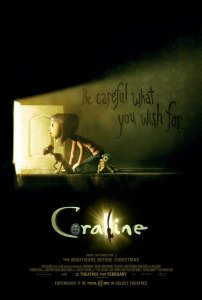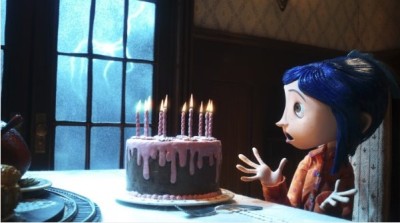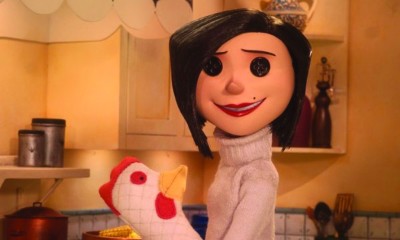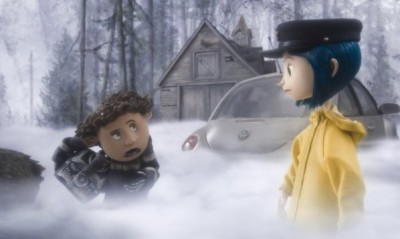By: debbie lynn elias
 Technology and the public have finally embraced 3-D – and I’m not talking the 3-D experience of the 50’s. No way. This is 21st Century 3-D. Digital. Real D. Call the various processes what you will, but 3-D is now perfected to the point of little if any compromise or distortion resulting in sharp, stunning, crisp, vibrant, razor edged imagery that boggles the mind with an eye popping visual experience. A perfect medium for a director like Henry Selick. An even more perfect medium for Neil Gaiman’s wondrous and imaginative dark fantasy “Coraline.” Combine the two, and toss in the art of stop motion animation, and you wind up with a film that is already on my list of Must See Films for 2009 and undoubtedly an Oscar nominee next year, a glistening web of fantastical and magical (and technical) delights – CORALINE.
Technology and the public have finally embraced 3-D – and I’m not talking the 3-D experience of the 50’s. No way. This is 21st Century 3-D. Digital. Real D. Call the various processes what you will, but 3-D is now perfected to the point of little if any compromise or distortion resulting in sharp, stunning, crisp, vibrant, razor edged imagery that boggles the mind with an eye popping visual experience. A perfect medium for a director like Henry Selick. An even more perfect medium for Neil Gaiman’s wondrous and imaginative dark fantasy “Coraline.” Combine the two, and toss in the art of stop motion animation, and you wind up with a film that is already on my list of Must See Films for 2009 and undoubtedly an Oscar nominee next year, a glistening web of fantastical and magical (and technical) delights – CORALINE.
How many times have you wished you were somewhere else? Wished your parents were different? Your life was different? Your house was different? As kids, particularly at 10 or 11 or 12, I think we all did. As adults today, we probably still do. Coraline Jones is no different. Having just been uprooted from her friends in Michigan, Coraline’s parents have relocated the family to Oregon where they now live in the Pink Palace. Oregon! What is there to do in Oregon? Frustrated and alone with nothing to do while her parents work on writing a gardening catalogue, the irrepressible and inquisitive Coraline tries her best to entertain herself but to no avail. Even her eccentric neighbors – Mr. Bobinsky with his pretend mouse circus, or the British actresses Miss Spink and Miss Forcible with their 248 angel Scottie dogs – don’t prove interesting to Coraline. Not even Wybie Lovat, a very interesting young man about Coraline’s age, can cheer her up. And then suddenly, a mysterious gift appears for Coraline – a hand sewn doll that looks just like Coraline, right down to her blue hair, but for one thing – the doll has button eyes.
That night as Coraline slept, strange things began to happen as she began to dream of a beautiful place, the “Other Place”, the “Other World” where everything was a duplicate of her real life, but brighter, happier, sunnier. Accessing it by crawling through a crawlspace door in her living room that is normally locked, this was the world that Coraline always dreamt of. Unlike the her Real Mother, her Other Mother cooked beautiful and delicious meals and doted on Coraline, bought trendy clothes for Coraline and showered her with love and attention; her Other Father was no longer a geek but a happy-go-lucky talented pianist, and rather dapper dresser; where the Other House was warm and cheery and her bedroom filled with ruffles and lace and butterflies; where Mr. Bobinsky really did have his mouse circus and Miss Spink and Miss Forcible performed opera on stage; a world where everyone except Coraline had button eyes. A world that also had one other creature there without button eyes, Wybie’s Cat. But in this world, Cat could talk.
Oh what wonderful places we go to in our dreams. But that’s all this was – a dream – for as Coraline awoke the next morning she found herself in her own boring bland bedroom with her undecorated walls, in her own boring house, no food in the fridge and the crawlspace door locked. How can that be? It was all so real. Believing that she belongs in the Other World, Coraline determines to re-enter it and re-enter it she does, regularly, but you know what they say about “be careful what you wish for.” With a little (okay, a lot) of help from Cat, it doesn’t take long for Coraline to realize that The Other World and the Other Mother are not what they appear and that she has now placed herself and her real family in serious danger. And just as she got herself into this situation, now Coraline must use her brains, spunk, determination and resourcefulness – plus a little help from Cat and Wybie – to get herself out of it and save herself and her real family.
Dakota Fanning voices Coraline and I can’t think of any actor more perfect. Her inflection and tonal qualities run the gamut of emotions. A little gasp tells an entire chapter of the story. She is captivating. As I watched this film, with every syllable and movement of Coraline, I could see Fanning before my eyes making the same movement, raising an eyebrow in disdain, pouting. It wasn’t until afterwards I learned that during the dialogue recording sessions, Fanning was being videotaped, “so if there was anything I happened to do – a gesture or facial expression – they could put that into Coraline’s character.” Wise beyond her years, Fanning believes it’s “important to show children watching the movie” that Coraline can overcome her fears and that she can get out of the situation she got herself into and ultimately, that they can, too. “You just have to think and use your resources.”
Blowing me out of the water is Teri Hatcher. In her voiceover debut, she essentially does three voicings – Real Mother, Other Mother and Evil Other Mother. Being a mother herself, she came to the project because “it’s hard to find quality entertaining movies for the family, and that’s what Coraline is.” But also, being a mother, Hatcher knows the different voices of motherhood and here she uses them all – sublimely. According to Hatcher, as the project progressed she found her comfort zone and “became more confident in being humorous or more sarcastic or more evil.” 
Neil Gaiman’s children’s story, “Coraline”, was originally conceived for his daughter Holly in the early 1990’s. Filled with fun and fantasy and childhood bravura and courage, not to mention life lessons, unfortunately Gaiman put the story aside until his younger daughter Maddy came along, prompting Gaiman to sit and write this unfolding tale of fantastical adventure about a spunky little girl named Coraline Jones. On its release in 2002, “Coraline” was at the top of the NY Times best-seller list. While writing “Coraline”, Gaiman was intently watching films by director Henry Selick – “The Nightmare Before Christmas” and “James and the Giant Peach.” On finishing the “Coraline” manuscript, Gaiman knew it had to be put in the hands of Henry Selick to bring this fantastical world to the big screen.
It only took Selick a week after getting the manuscript to know he had to make this into a film, but it had to be a very special film. Writing the screenplay himself, his adaptation of Gaiman’s book is masterful. He not only translated Gaiman’s written word for the big screen, but he enhanced the experience of the book by expounding and expanding one’s imagination. The script is as creative, imaginative and magical, and just as warm and embraceable as the book. And Selick is faithful to the book. So readers, do not worry! This is probably the best example of a director writing his script as Selick was able to write with a visual flourish, a flourish that is clearly evident on screen. However, concerned about some of the “creepiness” as the Other World turns Evil, balance was important to Selick. “The sweetness is there. The dark and scary is there.”
Storyboarding in 2005, Selick decided that the only way to animate CORALINE was with stop-motion animation which perfectly melds imagination with tangible reality. Stop motion itself (you all know it – think Rankin-Bass’ ‘Rudolph the Red-Nosed Reindeer”) is shot single frame by single frame. 24 frames per second. But Selick wanted more. Bigger, better. So he went for broke with adding stereoscopic 3-D. This technologic marriage combined with a wonderful story, eye popping visuals, relatable and embraceable characters and perfect voice casting is quite simply, movie magic at its finest.
Technically, the film is superlative. The meticulousness of the stop motion process itself is mind-boggling. 28 puppets at 9 3/4″ tall had to be made just of Coraline. Thanks to technological advancements, the puppets for CORALINE have smooth expressive faces, something notably distinct from the Rankin-Bass days. Hand in hand with this update, combing sculpture, drawings, CG modeling and 3-D printing, Coraline has the ability to make over 200,000 facial expressions. In one scene, you will actually see 16 distinctly different facial expressions in less than 35 seconds. Using seven 3-D cameras covering 52 stages, the actual production required Herculean efforts. However, key to the stunning visuals and fluidity of this 3-D masterpiece is the fact that with today’s stereoscopic 3-D, audiences are now able to look at things with both eyes just as we normally do, as opposed to just a “single lens” from a camera. The depth perception of this film is beyond realistic and makes the entire screen appear “touchable.” 
Perhaps one of my favorite sequences of the film is the garden sequence in the “Other World.” Selick and his artisans have crafted the most beauteous Edenesque place on Earth with the garden. And remember – this is stop motion – each individual flower is hand-crafted, hand sculpted. This is not CG. Lilies are made from inside-out thimbles. Ping-pong balls are the centers of flowers. Popcorn kernels are cherry blossoms. The ingenuity of each detail is mesmerizing. Costuming was hand made and it fell to Deborah Cook, costume design fabricator to find the perfect fabrics to make clothes that age 11 and 12 girls today would wear. So intent on perfection, for fabric alone, shops in London, LA and San Francisco were scoured. Hair is actually mohair laden with thin wiring.
Crediting the merging of stop-motion with 3-D has given Selick what he calls his “Wizard of Oz” moment. For me, Henry Selick is the Wizard in his own Emerald City, where a good book, great script, great cast, fantasy and technology all come together on their own yellow brick road bringing the Other World and the Real World into Our World with CORALINE. This is THE Best Picture of the Year.
Coraline Jones – Dakota Fanning Mother/Other Mother – Teri Hatcher
Written and directed by Henry Selick based on the novel by Neil Gaiman.












